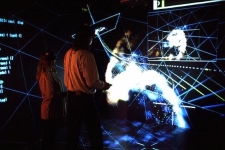|
|

Cosmology Team
Jerry Ostriker jpo@astro.princeton.edu 609-258-3026
Michael Norman norman@ncsa.uiuc.edu 217-244-6099
Visualizing the Formation of the First Star in the Universe
Michael Norman norman@ncsa.uiuc.edu 217-244-6099
Stuart Levy slevy@ncsa.uiuc.edu
John Shalf jshalf@ncsa.uiuc.edu
Adaptive mesh refinement is used in numerical cosmology to achieve very high resolution in and around forming astrophysics objects such as stars and galaxies. Unfortunately, the data from such simulations cannot be visualized using existing software due to the complex grid hierarchy data structure that AMR relies on. Here we have adapted the EVL/NCSA Virtual Director software to circumvent these problems. For the first time, we can effortlessly navigate space, time, and spatial scale in a virtual environment. Interactive virtual navigation of AMR data sets. Here we view the formation of the first stars in the universe. In this demo we will use the NCSA Virtual Director(TM) software to visualize the results of a numerical simulation of the formation of the first star in the universe. The star forms via gravitational collapse of a density fluctuation present in the young universe (a few million years after the Big Bang). The gas cools and condenses to near stellar densities via infrared line radiation from molecular hydrogen which forms in the gas phase via nonequilibrium chemical kinetic processes. Gravitational collapse generates an enormous range of spatial scales to be resolved in the simulation. This is accomplished using adaptive mesh refinement (AMR). The AMR datasets consist of a logical hierarchy of grid patches 13 levels of refinement deep. All told, nearly 500 grid patches are distributed across the levels. On each grid patch are solved the equations of gas dynamics, multispecies rate equations, gravity and dark matter dynamics. Using the Virtual Director(TM), we are able to navigate space, time and spatial scale with an intuitive interface, and record our journey with a virtual video camera. Adaptive mesh refinement visualization is a frontier area in computational science. Many disciplines are beginning to use AMR to increase resolution. The work is a collaborative effort between the Cosmology Application Team and the NCSA Visualization and Virtual Environments group. Hardware and software requirements: SGI Octane with 512MB RAM minimum.
![]()
![[Alliance]](http://www.ncsa.uiuc.edu/includes/footer-alliancelogo2.gif)
|
|